Human Resource Management: Policies, Competitive Advantage, and Cases
VerifiedAdded on 2021/12/03
|13
|3323
|304
Report
AI Summary
This report explores the crucial role of Human Resource Management (HRM) in enhancing a company's competitive advantage. It delves into various HRM policies, such as employment security, selective recruitment, incentive pay, and training and skill development, illustrating how they contribute to a firm's success. The report also examines the impact of the external environment, including physical, technological, and social factors, on HRM practices. Furthermore, it provides a case study of the Prudential Company in the UK, highlighting their HRM strategies like professionalism, customer satisfaction, and training programs, which have helped them maintain a competitive edge. The report concludes by emphasizing the interconnectedness of HRM policies and organizational outcomes, offering valuable insights for businesses aiming to leverage their human capital for sustained competitive advantage.
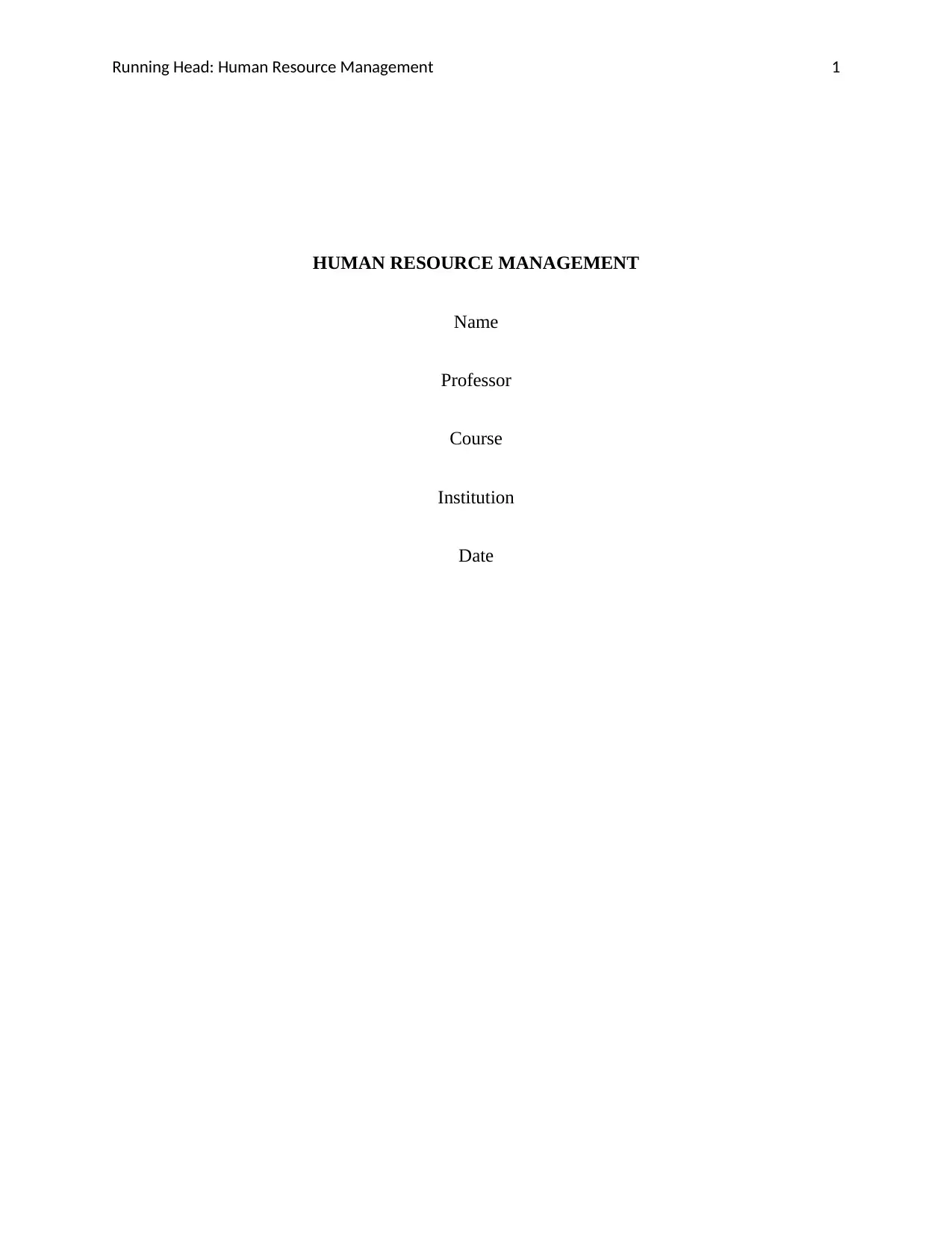
Running Head: Human Resource Management 1
HUMAN RESOURCE MANAGEMENT
Name
Professor
Course
Institution
Date
HUMAN RESOURCE MANAGEMENT
Name
Professor
Course
Institution
Date
Paraphrase This Document
Need a fresh take? Get an instant paraphrase of this document with our AI Paraphraser
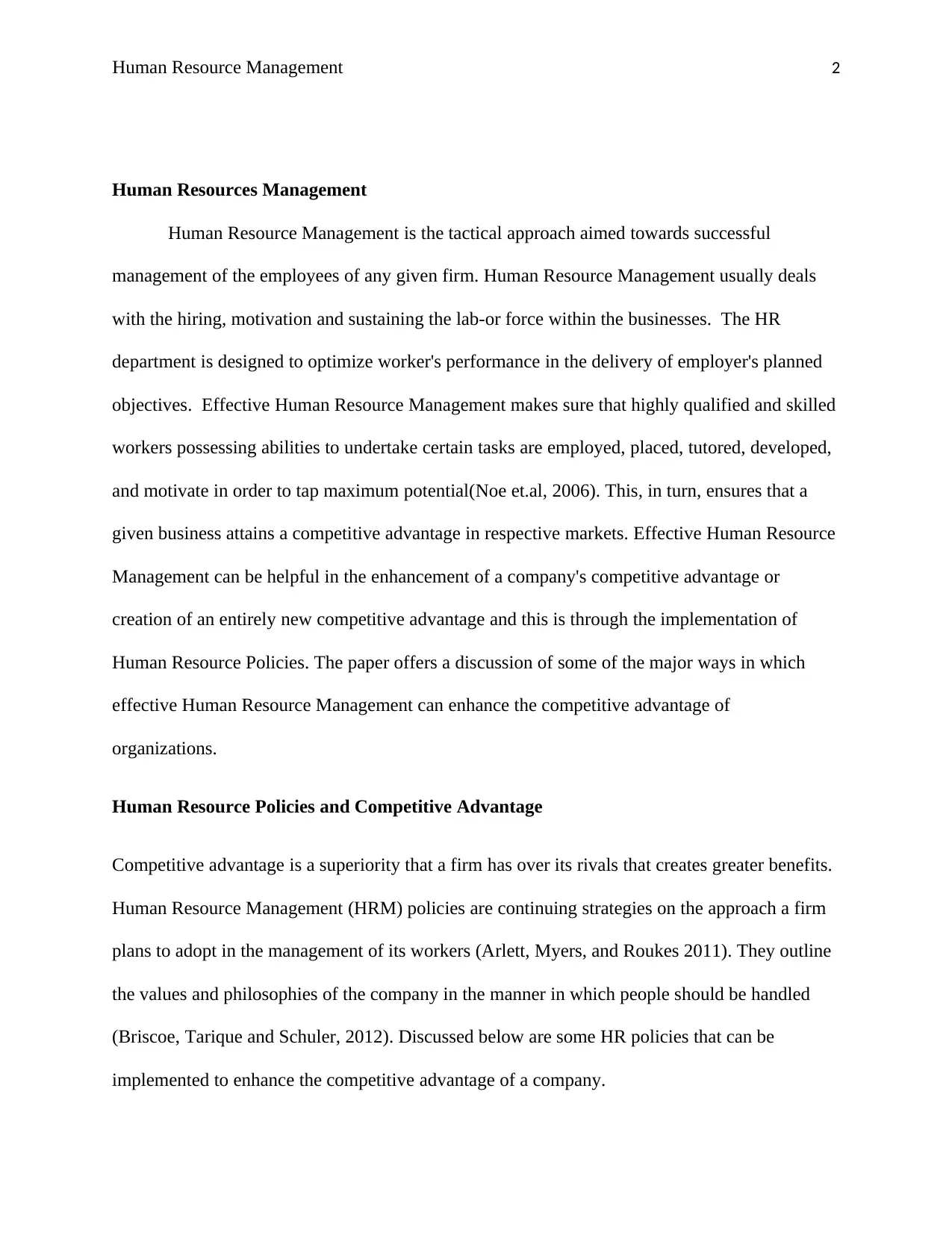
Human Resource Management 2
Human Resources Management
Human Resource Management is the tactical approach aimed towards successful
management of the employees of any given firm. Human Resource Management usually deals
with the hiring, motivation and sustaining the lab-or force within the businesses. The HR
department is designed to optimize worker's performance in the delivery of employer's planned
objectives. Effective Human Resource Management makes sure that highly qualified and skilled
workers possessing abilities to undertake certain tasks are employed, placed, tutored, developed,
and motivate in order to tap maximum potential(Noe et.al, 2006). This, in turn, ensures that a
given business attains a competitive advantage in respective markets. Effective Human Resource
Management can be helpful in the enhancement of a company's competitive advantage or
creation of an entirely new competitive advantage and this is through the implementation of
Human Resource Policies. The paper offers a discussion of some of the major ways in which
effective Human Resource Management can enhance the competitive advantage of
organizations.
Human Resource Policies and Competitive Advantage
Competitive advantage is a superiority that a firm has over its rivals that creates greater benefits.
Human Resource Management (HRM) policies are continuing strategies on the approach a firm
plans to adopt in the management of its workers (Arlett, Myers, and Roukes 2011). They outline
the values and philosophies of the company in the manner in which people should be handled
(Briscoe, Tarique and Schuler, 2012). Discussed below are some HR policies that can be
implemented to enhance the competitive advantage of a company.
Human Resources Management
Human Resource Management is the tactical approach aimed towards successful
management of the employees of any given firm. Human Resource Management usually deals
with the hiring, motivation and sustaining the lab-or force within the businesses. The HR
department is designed to optimize worker's performance in the delivery of employer's planned
objectives. Effective Human Resource Management makes sure that highly qualified and skilled
workers possessing abilities to undertake certain tasks are employed, placed, tutored, developed,
and motivate in order to tap maximum potential(Noe et.al, 2006). This, in turn, ensures that a
given business attains a competitive advantage in respective markets. Effective Human Resource
Management can be helpful in the enhancement of a company's competitive advantage or
creation of an entirely new competitive advantage and this is through the implementation of
Human Resource Policies. The paper offers a discussion of some of the major ways in which
effective Human Resource Management can enhance the competitive advantage of
organizations.
Human Resource Policies and Competitive Advantage
Competitive advantage is a superiority that a firm has over its rivals that creates greater benefits.
Human Resource Management (HRM) policies are continuing strategies on the approach a firm
plans to adopt in the management of its workers (Arlett, Myers, and Roukes 2011). They outline
the values and philosophies of the company in the manner in which people should be handled
(Briscoe, Tarique and Schuler, 2012). Discussed below are some HR policies that can be
implemented to enhance the competitive advantage of a company.
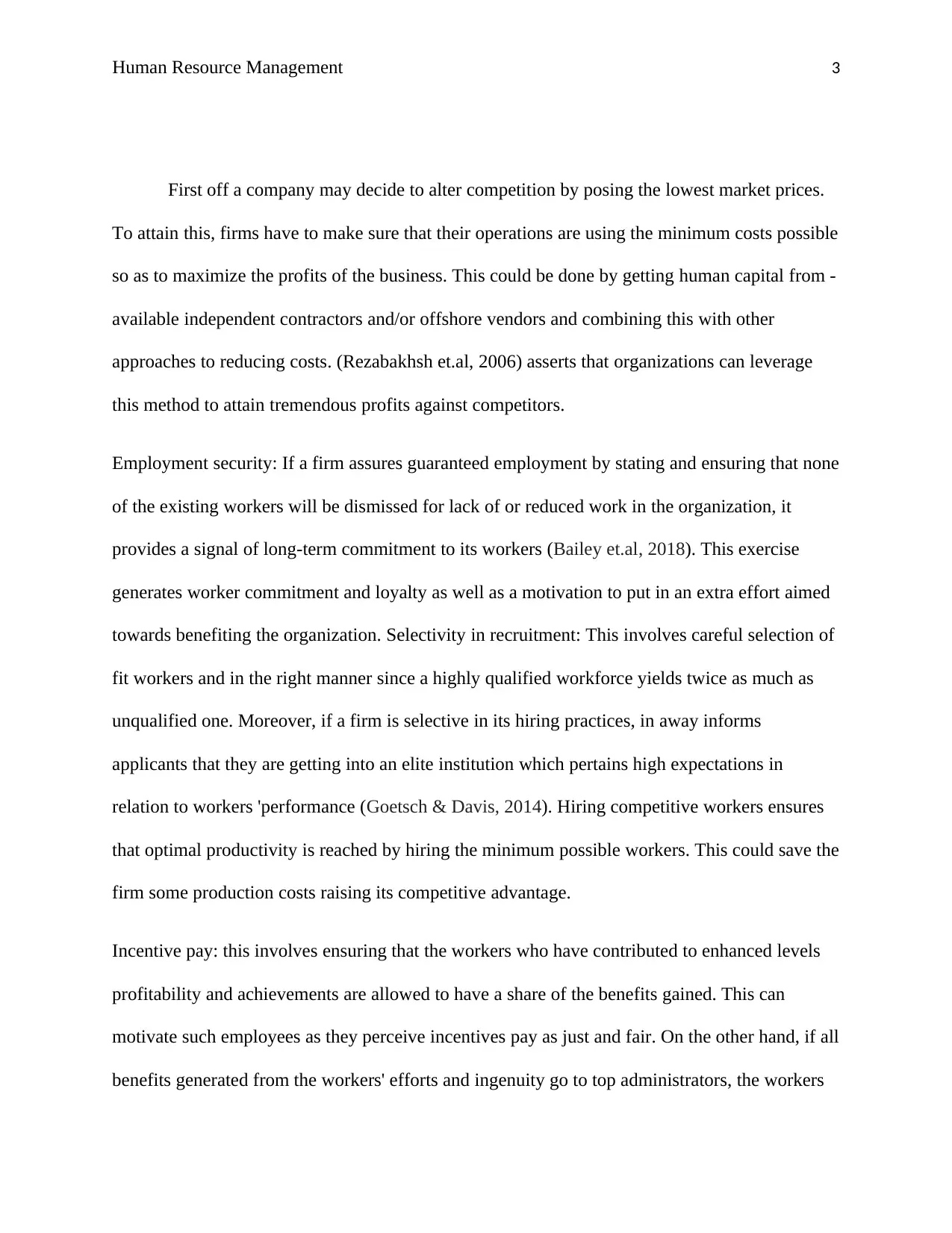
Human Resource Management 3
First off a company may decide to alter competition by posing the lowest market prices.
To attain this, firms have to make sure that their operations are using the minimum costs possible
so as to maximize the profits of the business. This could be done by getting human capital from -
available independent contractors and/or offshore vendors and combining this with other
approaches to reducing costs. (Rezabakhsh et.al, 2006) asserts that organizations can leverage
this method to attain tremendous profits against competitors.
Employment security: If a firm assures guaranteed employment by stating and ensuring that none
of the existing workers will be dismissed for lack of or reduced work in the organization, it
provides a signal of long-term commitment to its workers (Bailey et.al, 2018). This exercise
generates worker commitment and loyalty as well as a motivation to put in an extra effort aimed
towards benefiting the organization. Selectivity in recruitment: This involves careful selection of
fit workers and in the right manner since a highly qualified workforce yields twice as much as
unqualified one. Moreover, if a firm is selective in its hiring practices, in away informs
applicants that they are getting into an elite institution which pertains high expectations in
relation to workers 'performance (Goetsch & Davis, 2014). Hiring competitive workers ensures
that optimal productivity is reached by hiring the minimum possible workers. This could save the
firm some production costs raising its competitive advantage.
Incentive pay: this involves ensuring that the workers who have contributed to enhanced levels
profitability and achievements are allowed to have a share of the benefits gained. This can
motivate such employees as they perceive incentives pay as just and fair. On the other hand, if all
benefits generated from the workers' efforts and ingenuity go to top administrators, the workers
First off a company may decide to alter competition by posing the lowest market prices.
To attain this, firms have to make sure that their operations are using the minimum costs possible
so as to maximize the profits of the business. This could be done by getting human capital from -
available independent contractors and/or offshore vendors and combining this with other
approaches to reducing costs. (Rezabakhsh et.al, 2006) asserts that organizations can leverage
this method to attain tremendous profits against competitors.
Employment security: If a firm assures guaranteed employment by stating and ensuring that none
of the existing workers will be dismissed for lack of or reduced work in the organization, it
provides a signal of long-term commitment to its workers (Bailey et.al, 2018). This exercise
generates worker commitment and loyalty as well as a motivation to put in an extra effort aimed
towards benefiting the organization. Selectivity in recruitment: This involves careful selection of
fit workers and in the right manner since a highly qualified workforce yields twice as much as
unqualified one. Moreover, if a firm is selective in its hiring practices, in away informs
applicants that they are getting into an elite institution which pertains high expectations in
relation to workers 'performance (Goetsch & Davis, 2014). Hiring competitive workers ensures
that optimal productivity is reached by hiring the minimum possible workers. This could save the
firm some production costs raising its competitive advantage.
Incentive pay: this involves ensuring that the workers who have contributed to enhanced levels
profitability and achievements are allowed to have a share of the benefits gained. This can
motivate such employees as they perceive incentives pay as just and fair. On the other hand, if all
benefits generated from the workers' efforts and ingenuity go to top administrators, the workers
⊘ This is a preview!⊘
Do you want full access?
Subscribe today to unlock all pages.

Trusted by 1+ million students worldwide
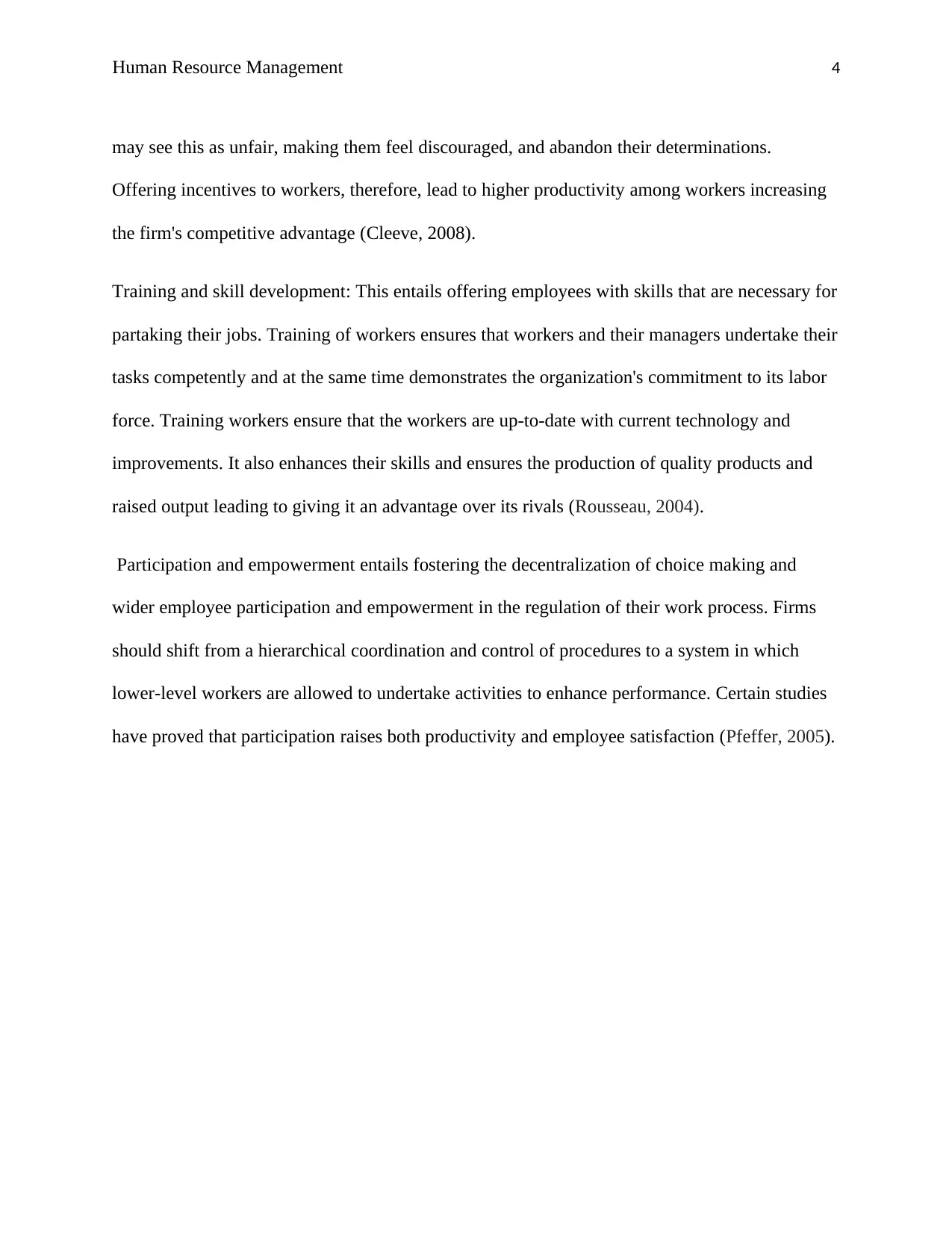
Human Resource Management 4
may see this as unfair, making them feel discouraged, and abandon their determinations.
Offering incentives to workers, therefore, lead to higher productivity among workers increasing
the firm's competitive advantage (Cleeve, 2008).
Training and skill development: This entails offering employees with skills that are necessary for
partaking their jobs. Training of workers ensures that workers and their managers undertake their
tasks competently and at the same time demonstrates the organization's commitment to its labor
force. Training workers ensure that the workers are up-to-date with current technology and
improvements. It also enhances their skills and ensures the production of quality products and
raised output leading to giving it an advantage over its rivals (Rousseau, 2004).
Participation and empowerment entails fostering the decentralization of choice making and
wider employee participation and empowerment in the regulation of their work process. Firms
should shift from a hierarchical coordination and control of procedures to a system in which
lower-level workers are allowed to undertake activities to enhance performance. Certain studies
have proved that participation raises both productivity and employee satisfaction (Pfeffer, 2005).
may see this as unfair, making them feel discouraged, and abandon their determinations.
Offering incentives to workers, therefore, lead to higher productivity among workers increasing
the firm's competitive advantage (Cleeve, 2008).
Training and skill development: This entails offering employees with skills that are necessary for
partaking their jobs. Training of workers ensures that workers and their managers undertake their
tasks competently and at the same time demonstrates the organization's commitment to its labor
force. Training workers ensure that the workers are up-to-date with current technology and
improvements. It also enhances their skills and ensures the production of quality products and
raised output leading to giving it an advantage over its rivals (Rousseau, 2004).
Participation and empowerment entails fostering the decentralization of choice making and
wider employee participation and empowerment in the regulation of their work process. Firms
should shift from a hierarchical coordination and control of procedures to a system in which
lower-level workers are allowed to undertake activities to enhance performance. Certain studies
have proved that participation raises both productivity and employee satisfaction (Pfeffer, 2005).
Paraphrase This Document
Need a fresh take? Get an instant paraphrase of this document with our AI Paraphraser
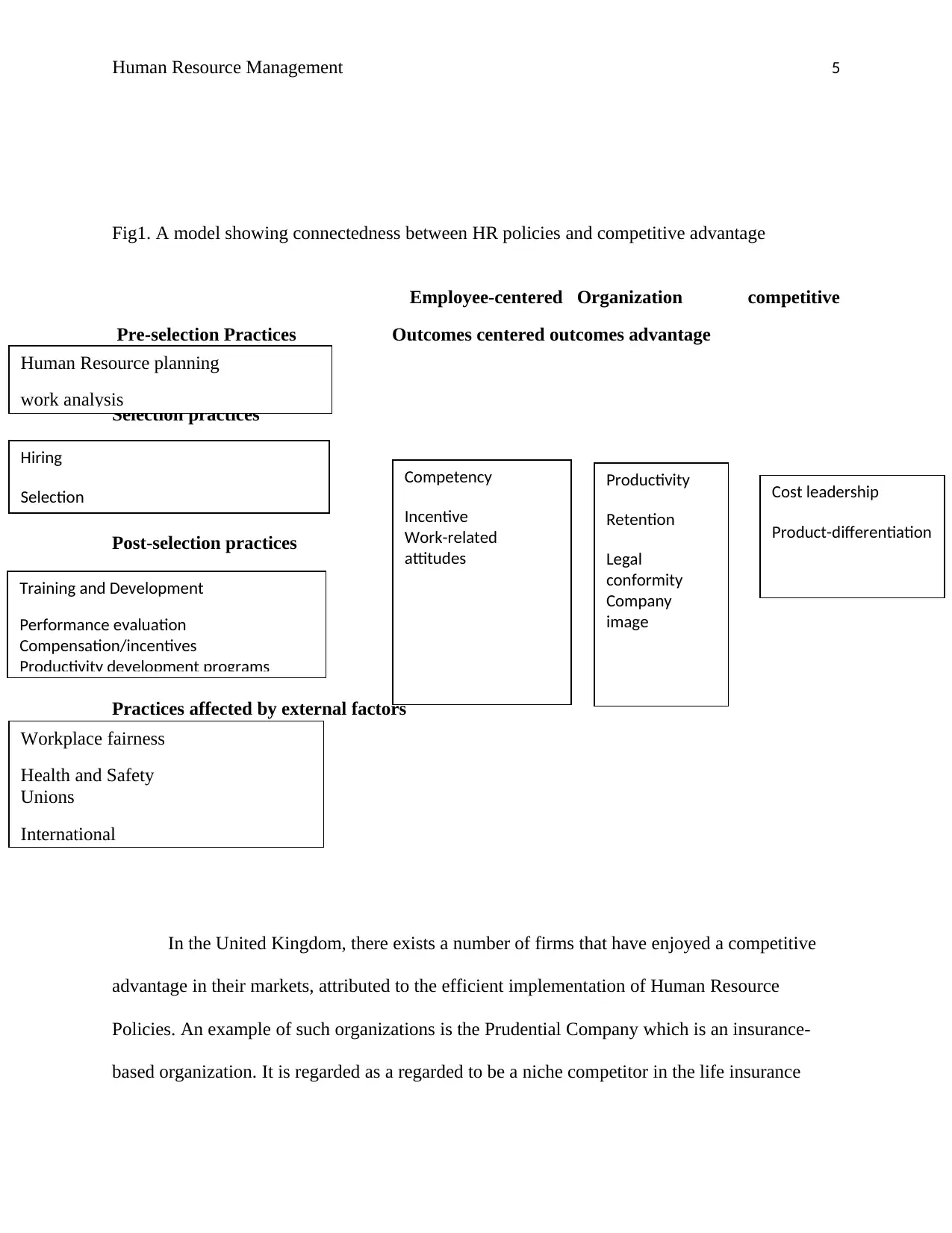
Human Resource Management 5
Fig1. A model showing connectedness between HR policies and competitive advantage
Employee-centered Organization competitive
Pre-selection Practices Outcomes centered outcomes advantage
Selection practices
Post-selection practices
Practices affected by external factors
2
In the United Kingdom, there exists a number of firms that have enjoyed a competitive
advantage in their markets, attributed to the efficient implementation of Human Resource
Policies. An example of such organizations is the Prudential Company which is an insurance-
based organization. It is regarded as a regarded to be a niche competitor in the life insurance
Training and Development
Performance evaluation
Compensation/incentives
Productivity development programs
Human Resource planning
work analysis
Hiring
Selection
Workplace fairness
Health and Safety
Unions
International
Competency
Incentive
Work-related
attitudes
Productivity
Retention
Legal
conformity
Company
image
Cost leadership
Product-differentiation
Fig1. A model showing connectedness between HR policies and competitive advantage
Employee-centered Organization competitive
Pre-selection Practices Outcomes centered outcomes advantage
Selection practices
Post-selection practices
Practices affected by external factors
2
In the United Kingdom, there exists a number of firms that have enjoyed a competitive
advantage in their markets, attributed to the efficient implementation of Human Resource
Policies. An example of such organizations is the Prudential Company which is an insurance-
based organization. It is regarded as a regarded to be a niche competitor in the life insurance
Training and Development
Performance evaluation
Compensation/incentives
Productivity development programs
Human Resource planning
work analysis
Hiring
Selection
Workplace fairness
Health and Safety
Unions
International
Competency
Incentive
Work-related
attitudes
Productivity
Retention
Legal
conformity
Company
image
Cost leadership
Product-differentiation
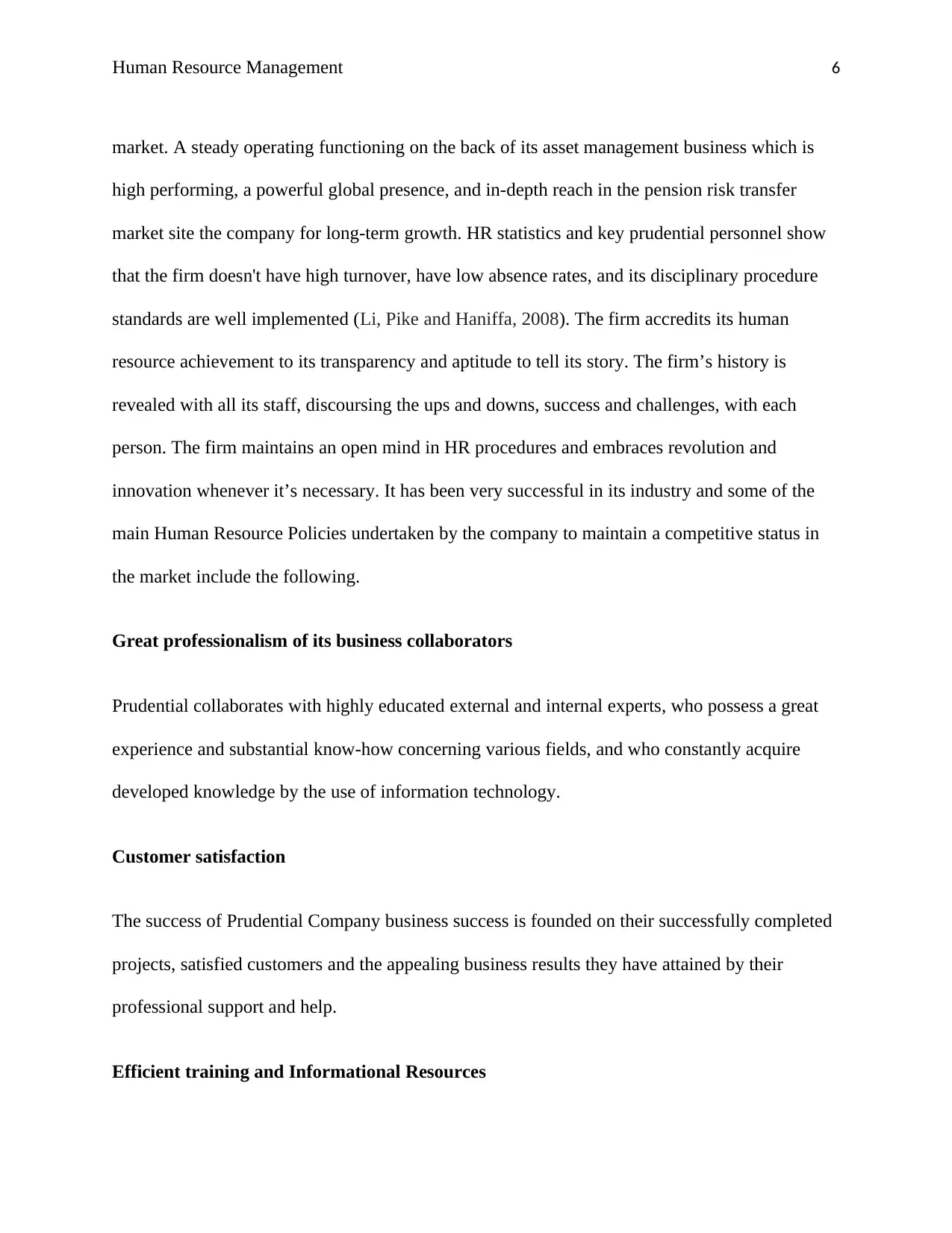
Human Resource Management 6
market. A steady operating functioning on the back of its asset management business which is
high performing, a powerful global presence, and in-depth reach in the pension risk transfer
market site the company for long-term growth. HR statistics and key prudential personnel show
that the firm doesn't have high turnover, have low absence rates, and its disciplinary procedure
standards are well implemented (Li, Pike and Haniffa, 2008). The firm accredits its human
resource achievement to its transparency and aptitude to tell its story. The firm’s history is
revealed with all its staff, discoursing the ups and downs, success and challenges, with each
person. The firm maintains an open mind in HR procedures and embraces revolution and
innovation whenever it’s necessary. It has been very successful in its industry and some of the
main Human Resource Policies undertaken by the company to maintain a competitive status in
the market include the following.
Great professionalism of its business collaborators
Prudential collaborates with highly educated external and internal experts, who possess a great
experience and substantial know-how concerning various fields, and who constantly acquire
developed knowledge by the use of information technology.
Customer satisfaction
The success of Prudential Company business success is founded on their successfully completed
projects, satisfied customers and the appealing business results they have attained by their
professional support and help.
Efficient training and Informational Resources
market. A steady operating functioning on the back of its asset management business which is
high performing, a powerful global presence, and in-depth reach in the pension risk transfer
market site the company for long-term growth. HR statistics and key prudential personnel show
that the firm doesn't have high turnover, have low absence rates, and its disciplinary procedure
standards are well implemented (Li, Pike and Haniffa, 2008). The firm accredits its human
resource achievement to its transparency and aptitude to tell its story. The firm’s history is
revealed with all its staff, discoursing the ups and downs, success and challenges, with each
person. The firm maintains an open mind in HR procedures and embraces revolution and
innovation whenever it’s necessary. It has been very successful in its industry and some of the
main Human Resource Policies undertaken by the company to maintain a competitive status in
the market include the following.
Great professionalism of its business collaborators
Prudential collaborates with highly educated external and internal experts, who possess a great
experience and substantial know-how concerning various fields, and who constantly acquire
developed knowledge by the use of information technology.
Customer satisfaction
The success of Prudential Company business success is founded on their successfully completed
projects, satisfied customers and the appealing business results they have attained by their
professional support and help.
Efficient training and Informational Resources
⊘ This is a preview!⊘
Do you want full access?
Subscribe today to unlock all pages.

Trusted by 1+ million students worldwide
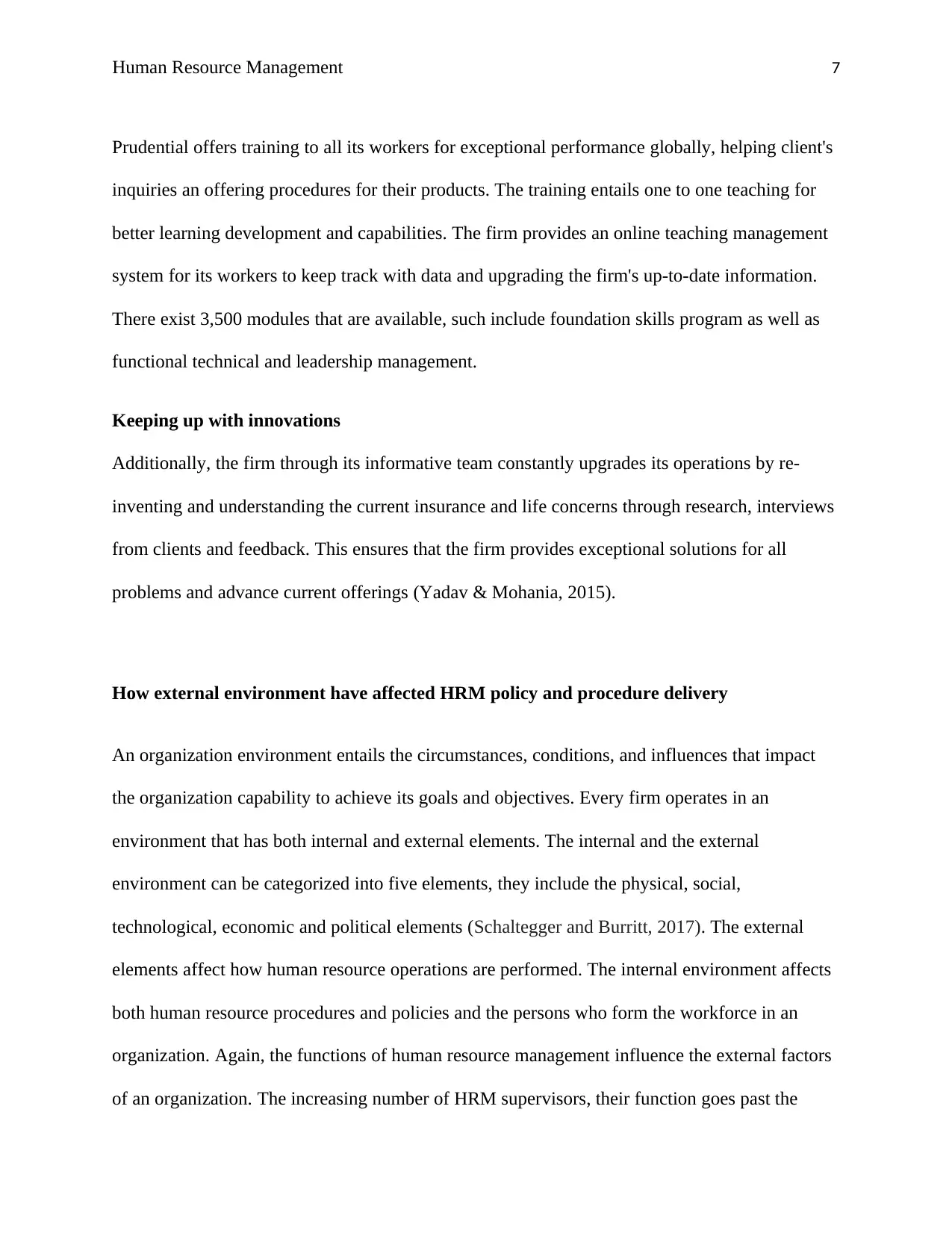
Human Resource Management 7
Prudential offers training to all its workers for exceptional performance globally, helping client's
inquiries an offering procedures for their products. The training entails one to one teaching for
better learning development and capabilities. The firm provides an online teaching management
system for its workers to keep track with data and upgrading the firm's up-to-date information.
There exist 3,500 modules that are available, such include foundation skills program as well as
functional technical and leadership management.
Keeping up with innovations
Additionally, the firm through its informative team constantly upgrades its operations by re-
inventing and understanding the current insurance and life concerns through research, interviews
from clients and feedback. This ensures that the firm provides exceptional solutions for all
problems and advance current offerings (Yadav & Mohania, 2015).
How external environment have affected HRM policy and procedure delivery
An organization environment entails the circumstances, conditions, and influences that impact
the organization capability to achieve its goals and objectives. Every firm operates in an
environment that has both internal and external elements. The internal and the external
environment can be categorized into five elements, they include the physical, social,
technological, economic and political elements (Schaltegger and Burritt, 2017). The external
elements affect how human resource operations are performed. The internal environment affects
both human resource procedures and policies and the persons who form the workforce in an
organization. Again, the functions of human resource management influence the external factors
of an organization. The increasing number of HRM supervisors, their function goes past the
Prudential offers training to all its workers for exceptional performance globally, helping client's
inquiries an offering procedures for their products. The training entails one to one teaching for
better learning development and capabilities. The firm provides an online teaching management
system for its workers to keep track with data and upgrading the firm's up-to-date information.
There exist 3,500 modules that are available, such include foundation skills program as well as
functional technical and leadership management.
Keeping up with innovations
Additionally, the firm through its informative team constantly upgrades its operations by re-
inventing and understanding the current insurance and life concerns through research, interviews
from clients and feedback. This ensures that the firm provides exceptional solutions for all
problems and advance current offerings (Yadav & Mohania, 2015).
How external environment have affected HRM policy and procedure delivery
An organization environment entails the circumstances, conditions, and influences that impact
the organization capability to achieve its goals and objectives. Every firm operates in an
environment that has both internal and external elements. The internal and the external
environment can be categorized into five elements, they include the physical, social,
technological, economic and political elements (Schaltegger and Burritt, 2017). The external
elements affect how human resource operations are performed. The internal environment affects
both human resource procedures and policies and the persons who form the workforce in an
organization. Again, the functions of human resource management influence the external factors
of an organization. The increasing number of HRM supervisors, their function goes past the
Paraphrase This Document
Need a fresh take? Get an instant paraphrase of this document with our AI Paraphraser
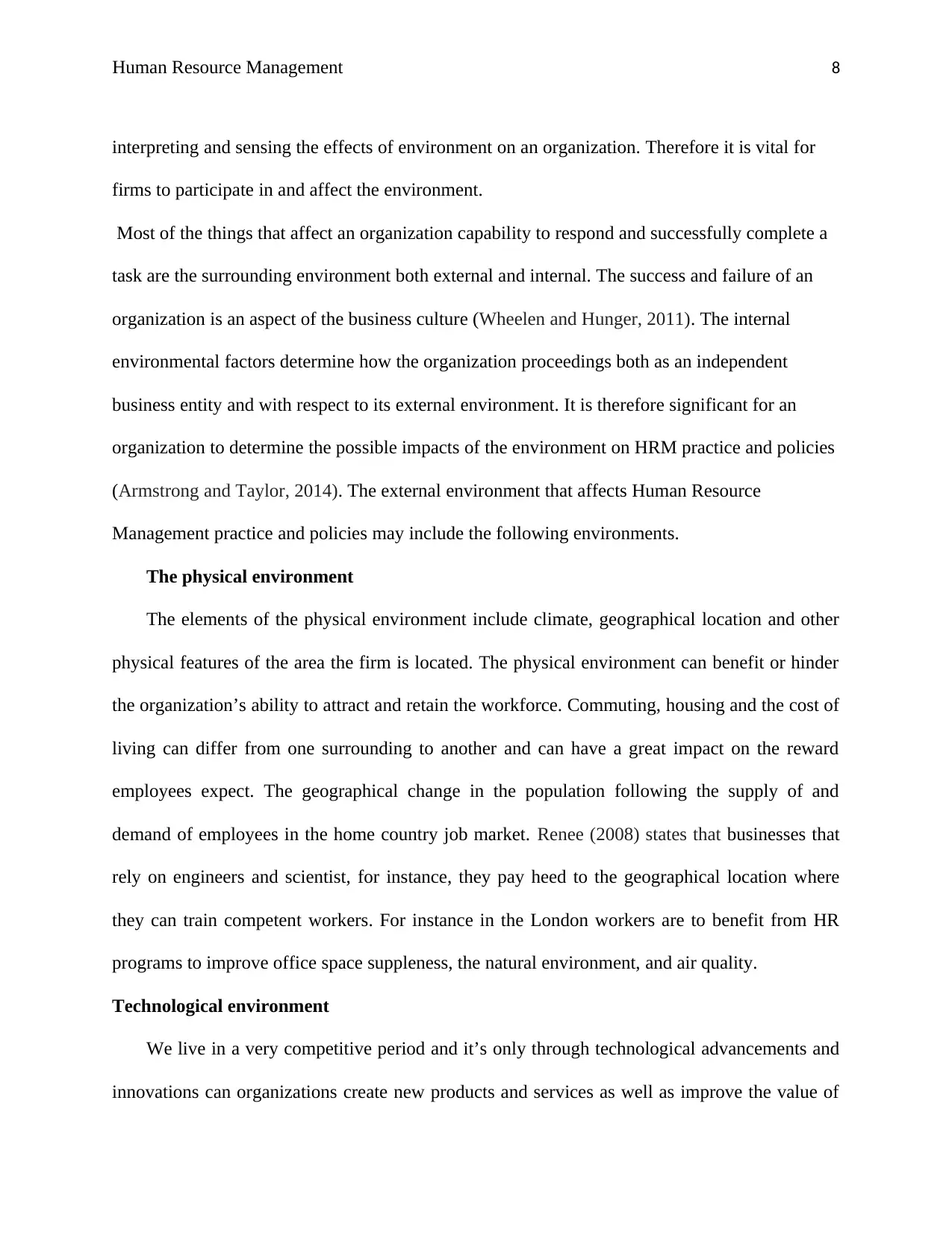
Human Resource Management 8
interpreting and sensing the effects of environment on an organization. Therefore it is vital for
firms to participate in and affect the environment.
Most of the things that affect an organization capability to respond and successfully complete a
task are the surrounding environment both external and internal. The success and failure of an
organization is an aspect of the business culture (Wheelen and Hunger, 2011). The internal
environmental factors determine how the organization proceedings both as an independent
business entity and with respect to its external environment. It is therefore significant for an
organization to determine the possible impacts of the environment on HRM practice and policies
(Armstrong and Taylor, 2014). The external environment that affects Human Resource
Management practice and policies may include the following environments.
The physical environment
The elements of the physical environment include climate, geographical location and other
physical features of the area the firm is located. The physical environment can benefit or hinder
the organization’s ability to attract and retain the workforce. Commuting, housing and the cost of
living can differ from one surrounding to another and can have a great impact on the reward
employees expect. The geographical change in the population following the supply of and
demand of employees in the home country job market. Renee (2008) states that businesses that
rely on engineers and scientist, for instance, they pay heed to the geographical location where
they can train competent workers. For instance in the London workers are to benefit from HR
programs to improve office space suppleness, the natural environment, and air quality.
Technological environment
We live in a very competitive period and it’s only through technological advancements and
innovations can organizations create new products and services as well as improve the value of
interpreting and sensing the effects of environment on an organization. Therefore it is vital for
firms to participate in and affect the environment.
Most of the things that affect an organization capability to respond and successfully complete a
task are the surrounding environment both external and internal. The success and failure of an
organization is an aspect of the business culture (Wheelen and Hunger, 2011). The internal
environmental factors determine how the organization proceedings both as an independent
business entity and with respect to its external environment. It is therefore significant for an
organization to determine the possible impacts of the environment on HRM practice and policies
(Armstrong and Taylor, 2014). The external environment that affects Human Resource
Management practice and policies may include the following environments.
The physical environment
The elements of the physical environment include climate, geographical location and other
physical features of the area the firm is located. The physical environment can benefit or hinder
the organization’s ability to attract and retain the workforce. Commuting, housing and the cost of
living can differ from one surrounding to another and can have a great impact on the reward
employees expect. The geographical change in the population following the supply of and
demand of employees in the home country job market. Renee (2008) states that businesses that
rely on engineers and scientist, for instance, they pay heed to the geographical location where
they can train competent workers. For instance in the London workers are to benefit from HR
programs to improve office space suppleness, the natural environment, and air quality.
Technological environment
We live in a very competitive period and it’s only through technological advancements and
innovations can organizations create new products and services as well as improve the value of
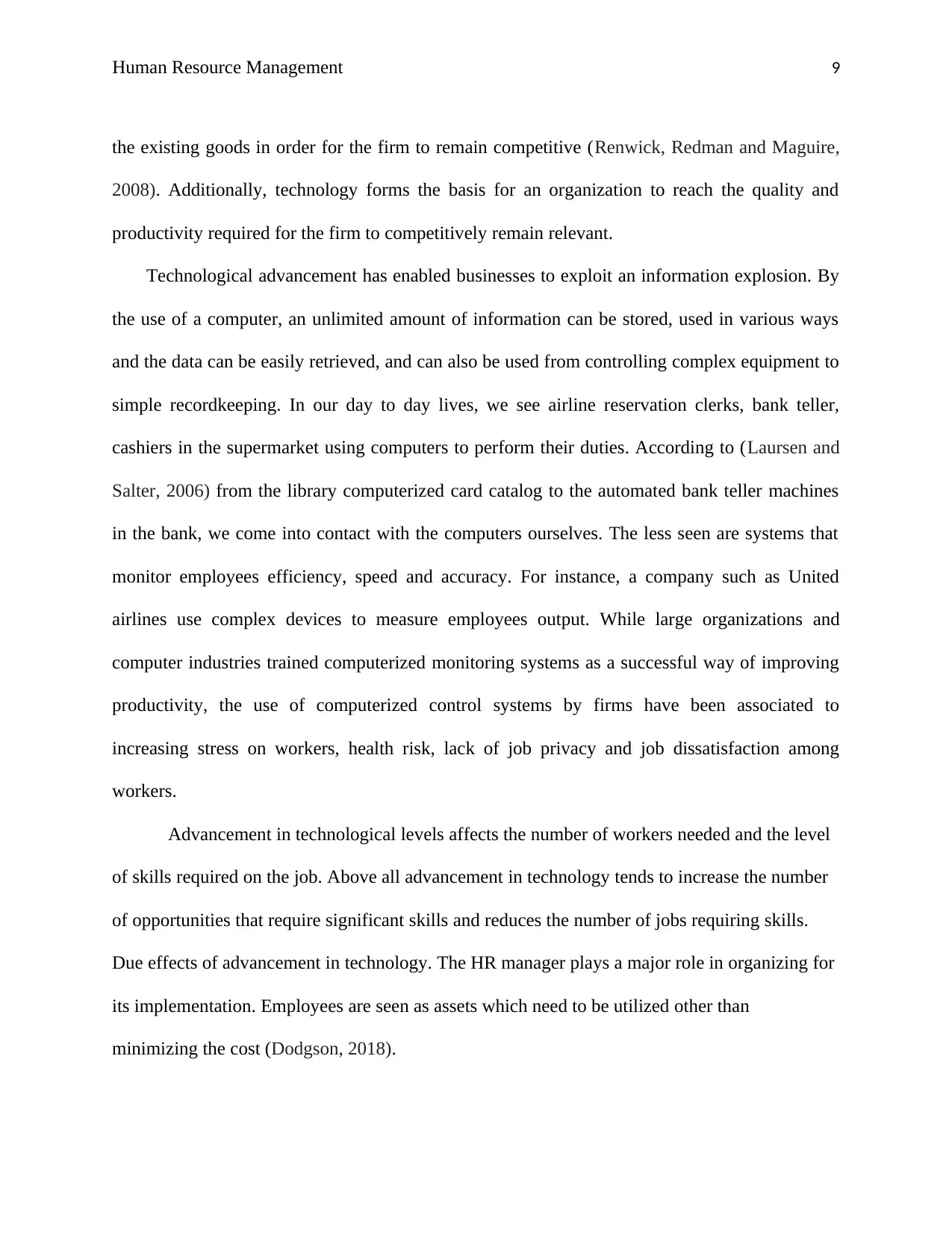
Human Resource Management 9
the existing goods in order for the firm to remain competitive (Renwick, Redman and Maguire,
2008). Additionally, technology forms the basis for an organization to reach the quality and
productivity required for the firm to competitively remain relevant.
Technological advancement has enabled businesses to exploit an information explosion. By
the use of a computer, an unlimited amount of information can be stored, used in various ways
and the data can be easily retrieved, and can also be used from controlling complex equipment to
simple recordkeeping. In our day to day lives, we see airline reservation clerks, bank teller,
cashiers in the supermarket using computers to perform their duties. According to (Laursen and
Salter, 2006) from the library computerized card catalog to the automated bank teller machines
in the bank, we come into contact with the computers ourselves. The less seen are systems that
monitor employees efficiency, speed and accuracy. For instance, a company such as United
airlines use complex devices to measure employees output. While large organizations and
computer industries trained computerized monitoring systems as a successful way of improving
productivity, the use of computerized control systems by firms have been associated to
increasing stress on workers, health risk, lack of job privacy and job dissatisfaction among
workers.
Advancement in technological levels affects the number of workers needed and the level
of skills required on the job. Above all advancement in technology tends to increase the number
of opportunities that require significant skills and reduces the number of jobs requiring skills.
Due effects of advancement in technology. The HR manager plays a major role in organizing for
its implementation. Employees are seen as assets which need to be utilized other than
minimizing the cost (Dodgson, 2018).
the existing goods in order for the firm to remain competitive (Renwick, Redman and Maguire,
2008). Additionally, technology forms the basis for an organization to reach the quality and
productivity required for the firm to competitively remain relevant.
Technological advancement has enabled businesses to exploit an information explosion. By
the use of a computer, an unlimited amount of information can be stored, used in various ways
and the data can be easily retrieved, and can also be used from controlling complex equipment to
simple recordkeeping. In our day to day lives, we see airline reservation clerks, bank teller,
cashiers in the supermarket using computers to perform their duties. According to (Laursen and
Salter, 2006) from the library computerized card catalog to the automated bank teller machines
in the bank, we come into contact with the computers ourselves. The less seen are systems that
monitor employees efficiency, speed and accuracy. For instance, a company such as United
airlines use complex devices to measure employees output. While large organizations and
computer industries trained computerized monitoring systems as a successful way of improving
productivity, the use of computerized control systems by firms have been associated to
increasing stress on workers, health risk, lack of job privacy and job dissatisfaction among
workers.
Advancement in technological levels affects the number of workers needed and the level
of skills required on the job. Above all advancement in technology tends to increase the number
of opportunities that require significant skills and reduces the number of jobs requiring skills.
Due effects of advancement in technology. The HR manager plays a major role in organizing for
its implementation. Employees are seen as assets which need to be utilized other than
minimizing the cost (Dodgson, 2018).
⊘ This is a preview!⊘
Do you want full access?
Subscribe today to unlock all pages.

Trusted by 1+ million students worldwide
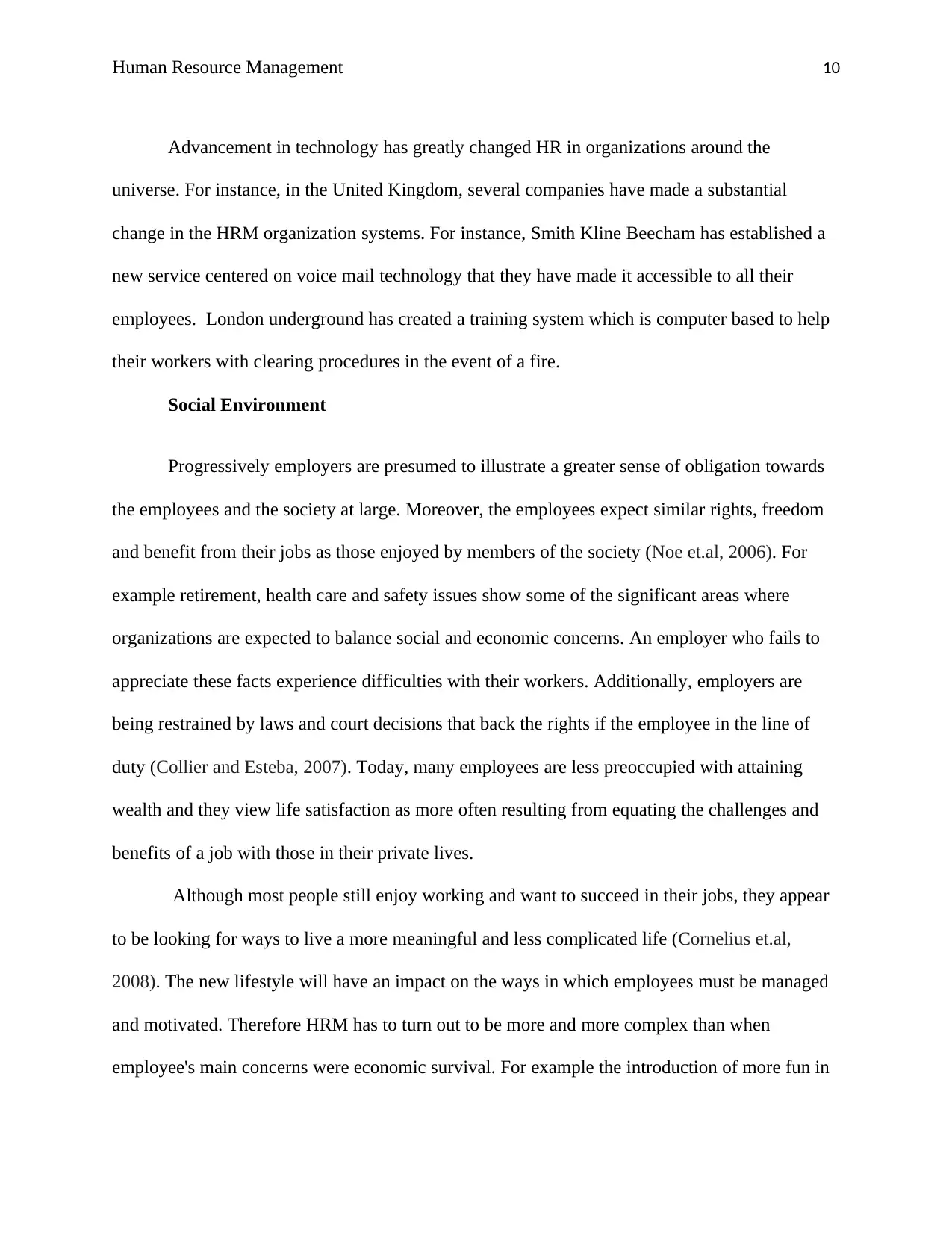
Human Resource Management 10
Advancement in technology has greatly changed HR in organizations around the
universe. For instance, in the United Kingdom, several companies have made a substantial
change in the HRM organization systems. For instance, Smith Kline Beecham has established a
new service centered on voice mail technology that they have made it accessible to all their
employees. London underground has created a training system which is computer based to help
their workers with clearing procedures in the event of a fire.
Social Environment
Progressively employers are presumed to illustrate a greater sense of obligation towards
the employees and the society at large. Moreover, the employees expect similar rights, freedom
and benefit from their jobs as those enjoyed by members of the society (Noe et.al, 2006). For
example retirement, health care and safety issues show some of the significant areas where
organizations are expected to balance social and economic concerns. An employer who fails to
appreciate these facts experience difficulties with their workers. Additionally, employers are
being restrained by laws and court decisions that back the rights if the employee in the line of
duty (Collier and Esteba, 2007). Today, many employees are less preoccupied with attaining
wealth and they view life satisfaction as more often resulting from equating the challenges and
benefits of a job with those in their private lives.
Although most people still enjoy working and want to succeed in their jobs, they appear
to be looking for ways to live a more meaningful and less complicated life (Cornelius et.al,
2008). The new lifestyle will have an impact on the ways in which employees must be managed
and motivated. Therefore HRM has to turn out to be more and more complex than when
employee's main concerns were economic survival. For example the introduction of more fun in
Advancement in technology has greatly changed HR in organizations around the
universe. For instance, in the United Kingdom, several companies have made a substantial
change in the HRM organization systems. For instance, Smith Kline Beecham has established a
new service centered on voice mail technology that they have made it accessible to all their
employees. London underground has created a training system which is computer based to help
their workers with clearing procedures in the event of a fire.
Social Environment
Progressively employers are presumed to illustrate a greater sense of obligation towards
the employees and the society at large. Moreover, the employees expect similar rights, freedom
and benefit from their jobs as those enjoyed by members of the society (Noe et.al, 2006). For
example retirement, health care and safety issues show some of the significant areas where
organizations are expected to balance social and economic concerns. An employer who fails to
appreciate these facts experience difficulties with their workers. Additionally, employers are
being restrained by laws and court decisions that back the rights if the employee in the line of
duty (Collier and Esteba, 2007). Today, many employees are less preoccupied with attaining
wealth and they view life satisfaction as more often resulting from equating the challenges and
benefits of a job with those in their private lives.
Although most people still enjoy working and want to succeed in their jobs, they appear
to be looking for ways to live a more meaningful and less complicated life (Cornelius et.al,
2008). The new lifestyle will have an impact on the ways in which employees must be managed
and motivated. Therefore HRM has to turn out to be more and more complex than when
employee's main concerns were economic survival. For example the introduction of more fun in
Paraphrase This Document
Need a fresh take? Get an instant paraphrase of this document with our AI Paraphraser
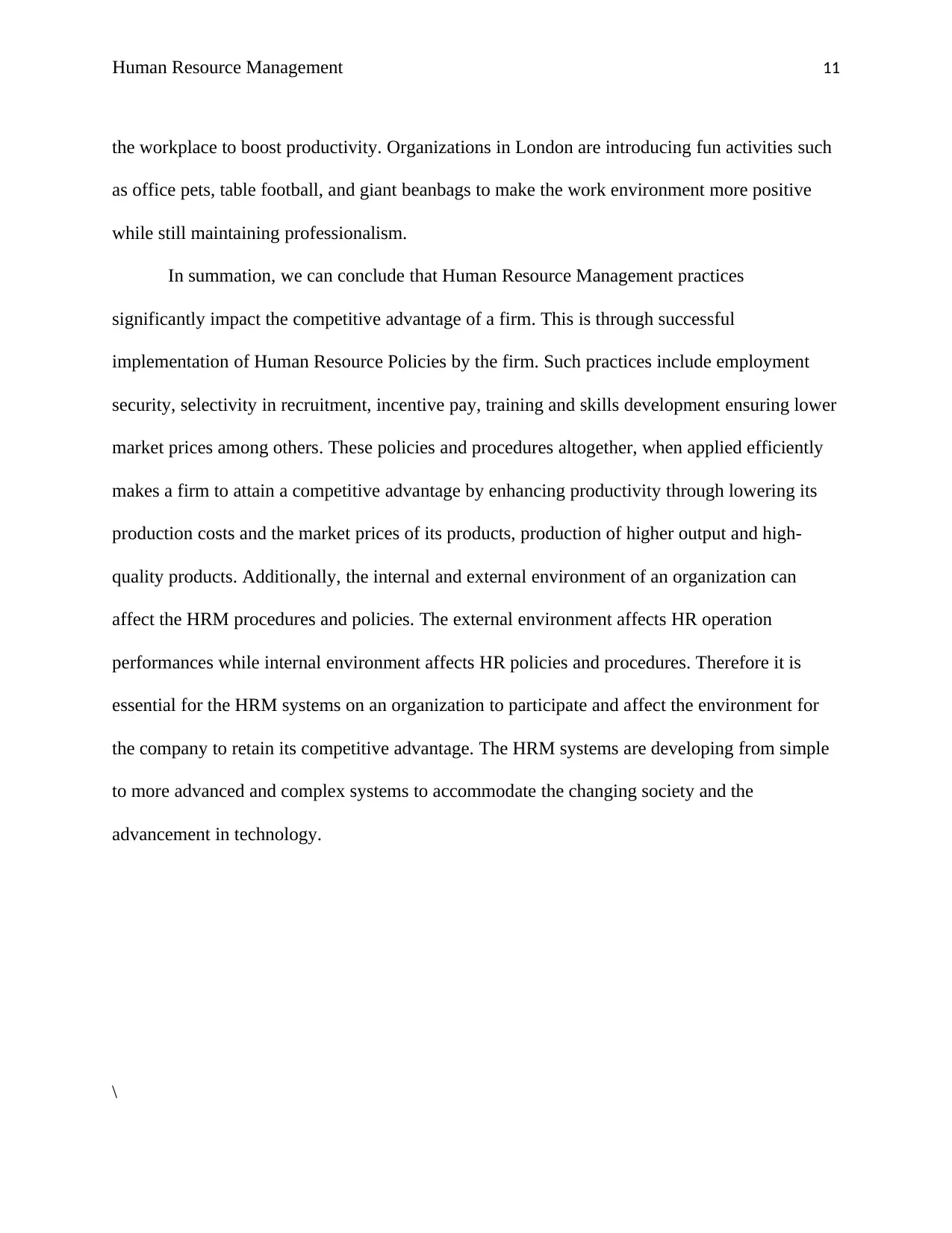
Human Resource Management 11
the workplace to boost productivity. Organizations in London are introducing fun activities such
as office pets, table football, and giant beanbags to make the work environment more positive
while still maintaining professionalism.
In summation, we can conclude that Human Resource Management practices
significantly impact the competitive advantage of a firm. This is through successful
implementation of Human Resource Policies by the firm. Such practices include employment
security, selectivity in recruitment, incentive pay, training and skills development ensuring lower
market prices among others. These policies and procedures altogether, when applied efficiently
makes a firm to attain a competitive advantage by enhancing productivity through lowering its
production costs and the market prices of its products, production of higher output and high-
quality products. Additionally, the internal and external environment of an organization can
affect the HRM procedures and policies. The external environment affects HR operation
performances while internal environment affects HR policies and procedures. Therefore it is
essential for the HRM systems on an organization to participate and affect the environment for
the company to retain its competitive advantage. The HRM systems are developing from simple
to more advanced and complex systems to accommodate the changing society and the
advancement in technology.
\
the workplace to boost productivity. Organizations in London are introducing fun activities such
as office pets, table football, and giant beanbags to make the work environment more positive
while still maintaining professionalism.
In summation, we can conclude that Human Resource Management practices
significantly impact the competitive advantage of a firm. This is through successful
implementation of Human Resource Policies by the firm. Such practices include employment
security, selectivity in recruitment, incentive pay, training and skills development ensuring lower
market prices among others. These policies and procedures altogether, when applied efficiently
makes a firm to attain a competitive advantage by enhancing productivity through lowering its
production costs and the market prices of its products, production of higher output and high-
quality products. Additionally, the internal and external environment of an organization can
affect the HRM procedures and policies. The external environment affects HR operation
performances while internal environment affects HR policies and procedures. Therefore it is
essential for the HRM systems on an organization to participate and affect the environment for
the company to retain its competitive advantage. The HRM systems are developing from simple
to more advanced and complex systems to accommodate the changing society and the
advancement in technology.
\
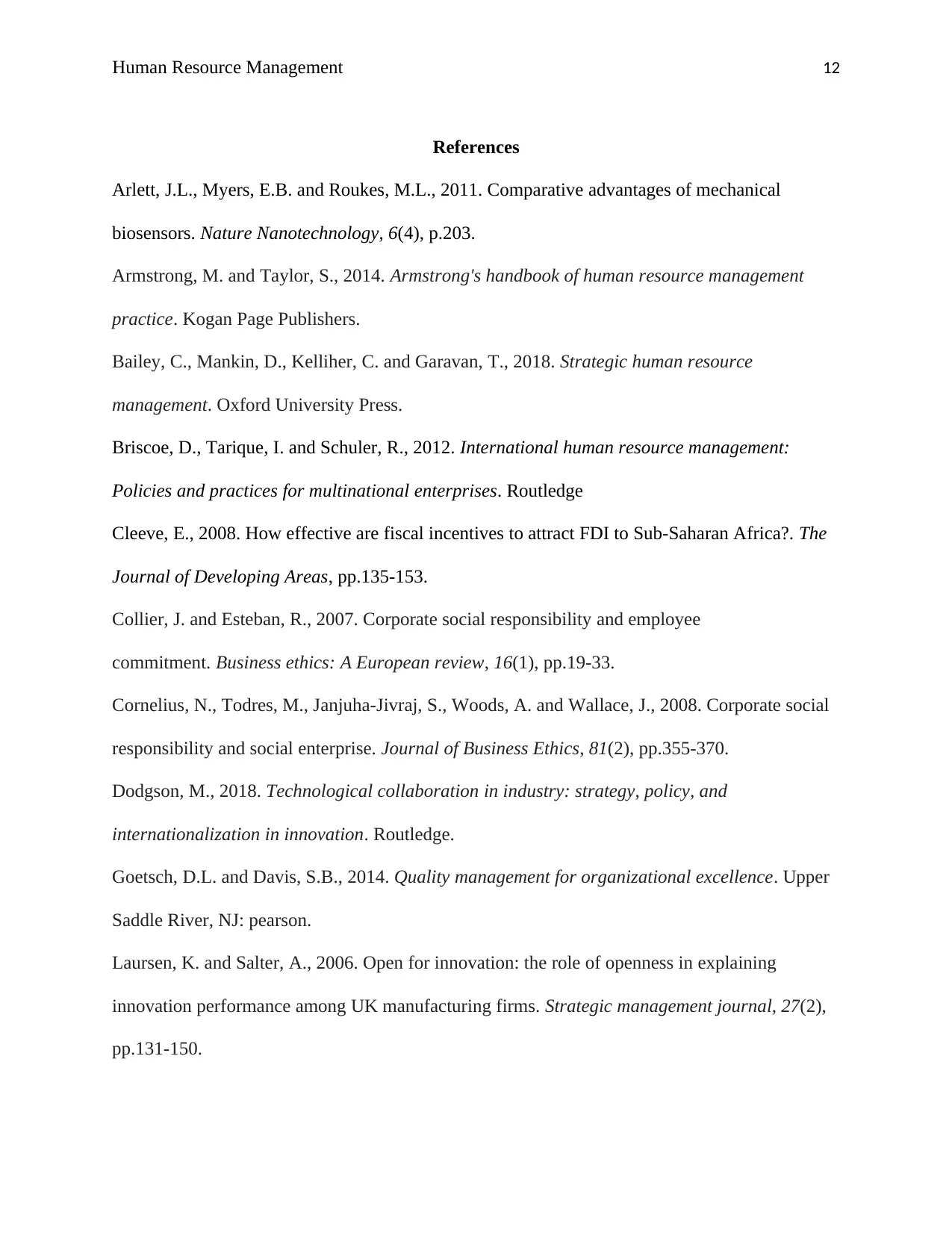
Human Resource Management 12
References
Arlett, J.L., Myers, E.B. and Roukes, M.L., 2011. Comparative advantages of mechanical
biosensors. Nature Nanotechnology, 6(4), p.203.
Armstrong, M. and Taylor, S., 2014. Armstrong's handbook of human resource management
practice. Kogan Page Publishers.
Bailey, C., Mankin, D., Kelliher, C. and Garavan, T., 2018. Strategic human resource
management. Oxford University Press.
Briscoe, D., Tarique, I. and Schuler, R., 2012. International human resource management:
Policies and practices for multinational enterprises. Routledge
Cleeve, E., 2008. How effective are fiscal incentives to attract FDI to Sub-Saharan Africa?. The
Journal of Developing Areas, pp.135-153.
Collier, J. and Esteban, R., 2007. Corporate social responsibility and employee
commitment. Business ethics: A European review, 16(1), pp.19-33.
Cornelius, N., Todres, M., Janjuha-Jivraj, S., Woods, A. and Wallace, J., 2008. Corporate social
responsibility and social enterprise. Journal of Business Ethics, 81(2), pp.355-370.
Dodgson, M., 2018. Technological collaboration in industry: strategy, policy, and
internationalization in innovation. Routledge.
Goetsch, D.L. and Davis, S.B., 2014. Quality management for organizational excellence. Upper
Saddle River, NJ: pearson.
Laursen, K. and Salter, A., 2006. Open for innovation: the role of openness in explaining
innovation performance among UK manufacturing firms. Strategic management journal, 27(2),
pp.131-150.
References
Arlett, J.L., Myers, E.B. and Roukes, M.L., 2011. Comparative advantages of mechanical
biosensors. Nature Nanotechnology, 6(4), p.203.
Armstrong, M. and Taylor, S., 2014. Armstrong's handbook of human resource management
practice. Kogan Page Publishers.
Bailey, C., Mankin, D., Kelliher, C. and Garavan, T., 2018. Strategic human resource
management. Oxford University Press.
Briscoe, D., Tarique, I. and Schuler, R., 2012. International human resource management:
Policies and practices for multinational enterprises. Routledge
Cleeve, E., 2008. How effective are fiscal incentives to attract FDI to Sub-Saharan Africa?. The
Journal of Developing Areas, pp.135-153.
Collier, J. and Esteban, R., 2007. Corporate social responsibility and employee
commitment. Business ethics: A European review, 16(1), pp.19-33.
Cornelius, N., Todres, M., Janjuha-Jivraj, S., Woods, A. and Wallace, J., 2008. Corporate social
responsibility and social enterprise. Journal of Business Ethics, 81(2), pp.355-370.
Dodgson, M., 2018. Technological collaboration in industry: strategy, policy, and
internationalization in innovation. Routledge.
Goetsch, D.L. and Davis, S.B., 2014. Quality management for organizational excellence. Upper
Saddle River, NJ: pearson.
Laursen, K. and Salter, A., 2006. Open for innovation: the role of openness in explaining
innovation performance among UK manufacturing firms. Strategic management journal, 27(2),
pp.131-150.
⊘ This is a preview!⊘
Do you want full access?
Subscribe today to unlock all pages.

Trusted by 1+ million students worldwide
1 out of 13
Related Documents
Your All-in-One AI-Powered Toolkit for Academic Success.
+13062052269
info@desklib.com
Available 24*7 on WhatsApp / Email
![[object Object]](/_next/static/media/star-bottom.7253800d.svg)
Unlock your academic potential
Copyright © 2020–2025 A2Z Services. All Rights Reserved. Developed and managed by ZUCOL.





